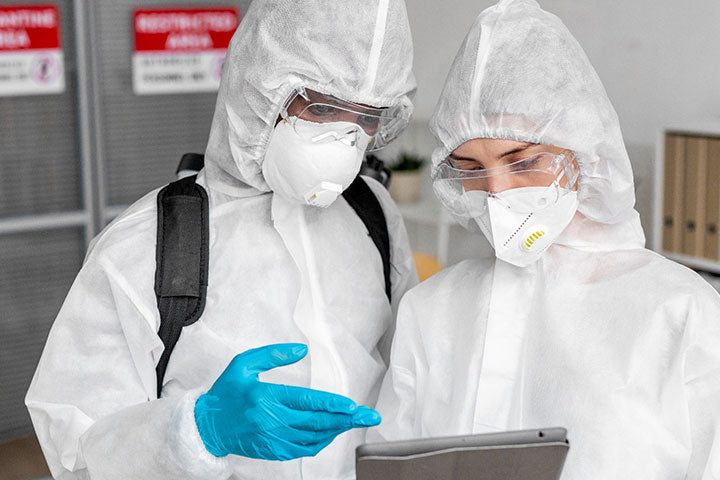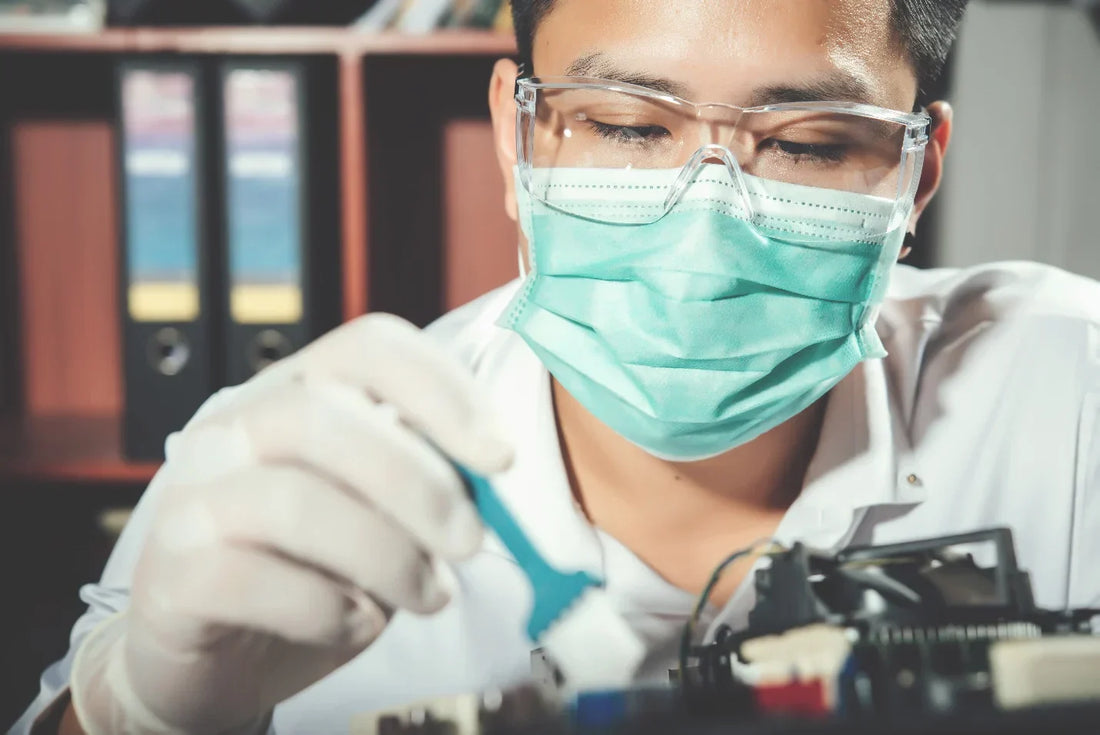Fume Hood Certification Requirements Every Lab Must Meet

Summary:
-
Fume hood certification confirms lab hoods meet safety and compliance standards.
-
Testing covers airflow, containment, alarms, and overall performance.
-
All hood types (conventional, VAV, ductless, specialty) require certification.
-
Common failures come from poor airflow, obstructions, or faulty parts.
-
Certification must be done by qualified professionals.
-
Non-compliance risks fines, downtime, legal issues, and reputational damage.
Introduction to Fume Hood Certification
Fume hood inspection and certification is the process of testing and verifying that a laboratory fume hood is functioning properly and meets recognized safety standards. They protect lab personnel and researchers from inhaling hazardous vapors, gases, and particulates by containing and removing contaminants. But simply having a fume hood is not enough; you must ensure the equipment is functional, and that is where certification comes in.
Certification tests your hood's performance against established standards such as ANSI/ASHRAE 110, SEFA guidelines, and other requirements from OSHA, NIH, CDC, and other governing bodies.
This blog examines hood certification requirements, including why they are necessary, what to expect from certification, and the associated costs of compliance. Whether you're a lab manager or technician, this blog will help you improve safety standards and achieve compliance in the lab.
Why Fume Hood Certification Is Non-Negotiable for Laboratories
Fume hoods are a lab's first line of defense against toxic vapors, gases, and particulates. However, without certification, there's no guarantee that the hoods are functioning as intended. This leaves lab personnel vulnerable to risks without warning.
Certification enhances compliance, safety, and accountability in every lab.
-
Compliance: OSHA's laboratory standard (29 CFR 1910.1450) requires hoods to be maintained and verified. Additional standards such as ANSI/ASHRAE 110, NFPA 45, and NIH guidelines establish formal testing protocols and annual certification requirements. Failure to comply with these standards may trigger penalties, shutdowns, or loss of research funding.
-
Safety: The fume hood is the primary device for protecting laboratory workers when working with flammable or toxic materials. Without certification, researchers may be unknowingly exposed to hazardous vapors every time they work. The Lab Manager reports that nearly 70% of hoods that fail containment tests still display acceptable airflow velocities, indicating that velocity alone is not a reliable indicator of safety.
-
Accountability: Certification provides legal backing for your operations. It provides documented proof that the lab has complied with relevant protocols and procedures to safeguard personnel and maintain research integrity. The documented evidence becomes invaluable in the event of an incident.
Overview of Certification Standards
Laboratory fume hood certification is guided by well-established standards that ensure safety and optimal performance. These standards define how hoods should be tested, outline the parameters that must be followed, and specify the frequency of certification required.
The following are key hood certification standards and their requirements:
-
OSHA (29 CFR 1910.1450): It mandates annual inspections and functional verification for laboratory ventilation systems, including fume hoods.
-
ANSI/ASHRAE 110: This is a common standard for fume hood performance testing in the U.S. It provides the test method of evaluating hood performance based on tracer gas tests, face velocity measurements, and airflow visualization.
-
NFPA 45: This focuses on fire safety and ventilation. It requires fume hoods to have exhaust systems that prevent fire spread, include clear labelling of safe sash heights, and be connected to emergency power when critical for safety.
ANSI/AIHA Z9.5: This standard provides performance criteria for laboratory ventilation systems. It requires annual testing of fume hoods, defines acceptable airflow rates, and emphasizes the importance of ongoing monitoring and maintenance.
Fume Hood Inspections & Certification Process

Lab hood certification involves a series of inspections and performance tests to ensure the hood is operating safely and effectively. The certification process is usually based on the ANSI/ASHRAE standard for testing fume hoods. Here are the key elements of the certification process:
Visual Inspection
The certifier begins with a visual check to identify obvious problems that could compromise performance. They check for damage, blockage, and missing components, while also verifying that the hood has key features, such as flow monitors and sash stops.
Face Velocity Test
The certifier uses an anemometer to measure the hood's face velocity at multiple points across the sash opening. It ensures it meets the industry-wide benchmark of 80-120 feet per minute (fpm). If the velocity is too low, contaminants might escape, and if it is too high, turbulence may push vapors back towards the operator.
Smoke Visualization
This testing provides proof that the hood is properly capturing and containing fumes. Smoke is released inside the hood, and the certifier observes characteristics such as turbulence, reverse flow, or leaks at the sash edges.
Tracer Gas Containment
A tracer gas, typically sulfur hexafluoride, is released into the hood while sensors measure leakage and the amount that reaches the operator's breathing zone using a mannequin. This test simulates real-world use and is considered the gold standard of chemical fume hood certification.
Airflow Visualization
The certifier uses smoke or streamers to visualize airflow patterns around the hood opening. It also checks for turbulence and dead spots that could allow the fumes to escape.
Alarms and Monitor Verification
Airflow alarms and monitors are tested to ensure they respond when airflow drops below safe limits. Sash stops and automatic sash closers are also tested to ensure they are working correctly.
Documentation and Certification
The certifier issues a certification report with test methods, airflow readings, tracer gas results, and a pass or fail status. The certification label is affixed to the hood showing the date of testing, expiration date, and the certifier's credentials.
Types of Fume Hoods That Require Certification
Every laboratory fume hood, regardless of design or application, requires certification.
-
Conventional (Bypass) Fume Hoods: Certification verifies face velocity uniformity and smoke visualization to confirm safe containment.
-
Constant Air Volume (CAV) Hoods: Certification focuses on consistent airflow across sash positions and proper face velocity range (80-120 fpm).
-
Variable Air Volume (VAV) Hoods: Certification focuses on sash position calibration, sensor/alarm testing, and tracer gas containment testing.
-
Ductless Fume Hoods: Certification focuses on airflow integrity and filter efficiency or saturation checks, since air is recirculated.
-
Radioisotope Hoods: Certification covers airflow containment and radiation shielding integrity.
-
Perchloric Acid Hoods: Certification focuses on ventilation performance, as well as wash-down and corrosion-resistant ductwork.
-
High-Performance/Low-Flow Hoods: Certification focuses on containment testing at reduced airflow rates, balancing safety with energy efficiency.
Who Is Qualified to Certify Fume Hoods?e
Not just anyone can certify a laboratory fume hood. Certification requires specialized training, calibrated equipment, and a thorough understanding of industry standards and regulations. Using an unqualified certifier can put your workers at risk.
When choosing a certifier for your equipment, look for:
Accredited Third-Party Certification Companies
Firms like R&D Laboratory Equipment employ trained technicians who follow ANSI/ASHRAE 110, ANSI/AIHA Z9.5, and other standardized protocols.
Manufacturer Certified Technicians
Some fume hood manufacturers provide training and certification programs for service contractors. These technicians are qualified to test hoods for both performance and warranty compliance.
Common Reasons for Fume Hood Certification Failure
There are many reasons why your exhaust hood certification might fail. They include:
-
Improper face velocity: If your hood's average velocity falls outside the recommended 80-120 feet per minute range, then containment can't be guaranteed, placing operators and lab personnel at risk.
-
Airflow obstructions: Storing bottles, boxes, or bulky objects inside the hood disrupts airflow. This creates dead spots where air doesn't flow properly, allowing vapors to escape into the room.
-
Damaged or misaligned sash: The sash is the barrier between workers and the hazard. If it is damaged or misaligned, the airflow pattern is changed, and containment can no longer be guaranteed.
-
Faulty alarms or airflow monitors: Without accurate alarms, workers may use a hood that does not protect them, which constitutes a major OSHA and ANSI violation.
Best Practices to Maintain Compliance Year-Round

Passing certification isn't enough. Fume hoods require ongoing maintenance and adherence to good laboratory practices to remain compliant with regulations. The following tips will help prevent compliance failure:
-
Schedule Annual Certification: OSHA and ANSI/AIHA Z9.5 recommend at least annual certification; however, high-use labs or ductless hoods may require semi-annual checks. This helps your lab stay compliant and catches minor issues before they become costly failures.
-
Perform Routine Checks: In-house maintenance checks, such as verifying sash height markers, active alarms, and unobstructed airflow, help prevent certification failure later.
-
Maintain Proper Hood Use Practices: Keep sash at recommended working height. Avoid storing bulky items or chemicals in the hood. Work at least six inches inside the hood opening to minimize the risk of backflow.
The Cost of Non-Compliance
Here's what non-compliance can cost your lab:
-
Regulatory penalties: Failure to comply with hood certification standards can result in fines, loss of funding, or business closure.
-
Legal liability: If an employee is injured or exposed to toxic fumes due to a failed or uncertified hood, the lab can face lawsuits, workers' compensation claims, and even criminal liability for negligence.
-
Downtime and lost productivity: A failed certification means the equipment is out of service and can't be used until repaired or retested. This halts all experimentation, delays projects, and disrupts workflow.
-
Equipment and repair costs: Neglecting certification can lead to more significant problems, such as sensor damage or blower failure. These components can cost thousands.
-
Reputational damage: A failed safety inspection can hurt a lab's reputation with its suppliers, sponsors, and industry partners.
Conclusion
Fume hood certification is not just about passing inspections. It's about protecting your people, your research, and your lab's reputation. Every step of certification, from annual inspections and airflow testing to tracer gas containment, helps you achieve this aim.
You can also enhance the functionality of your equipment and stay compliant with regulations by collaborating with qualified certifiers, scheduling regular inspections, and practicing proper hood use.
FAQs
1. How often should a fume hood be certified?
Most fume hoods must be certified at least once a year in accordance with OSHA and ANSI/AIHA Z9.5 standards. High-risk facilities or those handling hazardous chemicals may require more frequent checks.
2. Who can perform fume hood certification?
Certification should be performed by a qualified professional, such as an independent third-party certifier or a trained Environmental Health & Safety (EH&S) specialist. Look for providers accredited under ANSI, NSF, or AIHA guidelines.
3. What is tested during a lab hood certification?
A typical certification test includes face velocity testing, smoke pattern tests, tracer gas testing, and inspection of alarms and monitoring systems.
4. Is certification different for ductless vs. ducted fume hoods?
Yes. Ducted fume hoods are primarily tested for airflow and containment, while ductless fume hoods require additional tests, including filter integrity, saturation levels, and chemical breakthrough risks.
5. What happens if my fume hood fails inspection?
If your fume hood fails inspection, it will be tagged "out of service" until repairs are made or it is retested.
6. How long does the certification process take?
A single hood typically takes 30–60 minutes to certify, depending on the type of hood and the level of testing required.
7. What standards govern hood certification?
Key standards include OSHA 29 CFR 1910.1450, ANSI/ASHRAE 110, ANSI/AIHA Z9.5, and NFPA 45.
8. What are common reasons for certification failure?
Hoods often fail due to improper face velocity, blocked airflow, damaged sashes, or faulty alarms. Many of these issues are preventable with good lab practices.
9. How much does certification cost?
Pricing varies by hood type, testing level, and region, but most certifications range from $200 to $500 per hood. Complex hoods (radioisotope or perchloric acid hoods) may cost more due to additional safety checks.
10. What can labs do to remain compliant throughout the year?
Schedule annual or semi-annual certifications. Keep hoods free from clutter. Check airflow monitors and alarms regularly—train staff on the proper use of sashes and safe work practices.






